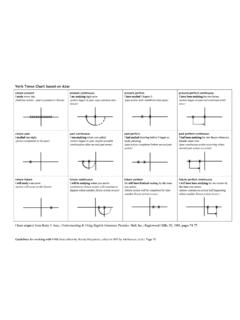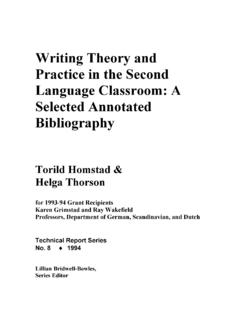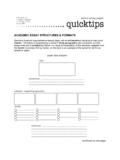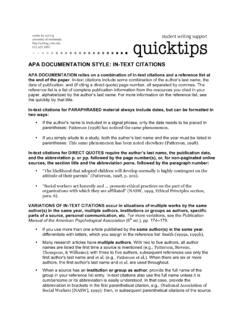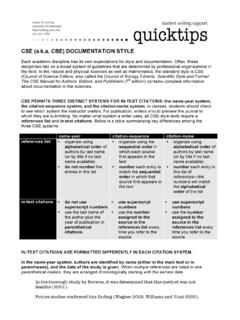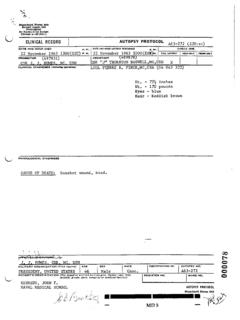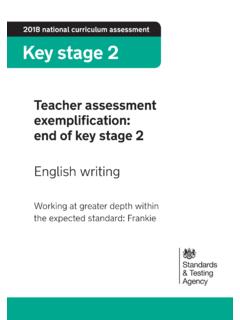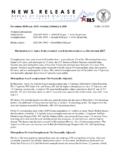Transcription of Writing Style Differences in Newspaper, Radio, and ...
1 Writing Style Differences in newspaper , Radio, and Television News Irving Fang University of Minnesota A monograph presented by the Center for Interdisciplinary Studies of Writing and the Composition, Literacy, and Rhetorical Studies Minor Monograph Series No. 2 1991 Lillian Bridwell-Bowles, Series Editor Writing Style Differences in newspaper , Radio, and Television News Irving Fang University of Minnesota A monograph presented for the Center for Interdisciplinary Studies of Writing and the Composition, Literacy, and Rhetorical Studies Minor Monograph Series No. 2 1991 Lillian Bridwell-Bowles, Series Editor Paul Prior, Research Fellow Writing Style Differences in newspaper , Radio, and Television News 2 Contents Introduction.
2 1 Leads ..10 Story Structure ..18 Sentence Structure ..20 Word Choice ..23 Names, Quotes and Attribution ..26 Appendix 1: Media Questionnaire ..32 Appendix 2: Professional Preparation for Writing in Journalism ..38 Bibliography ..41 Preface The members of the Center for Interdisciplinary Studies of Writing are pleased to publish this monograph on the features of Writing in three journalistic media: television, radio, and print. This project was appropriate because it accomplishes one of the Center's goals: sponsoring studies of Writing in particular fields or within a particular discipline. Each year, the Center invites faculty from the University of Minnesota to conduct studies of Writing in the following areas: characteristics of Writing across the University's curriculum; status reports on students' Writing ability at the University; the connections between Writing and learning in all fields; the characteristics of Writing beyond the academy; the effects of ethnicity, race, class and gender on Writing ; and curricular reform through Writing .
3 We receive a technical report from each, and these are available through the Center; when there is a wide audience for reports, we invite project directors to submit longer monographs. Professor Irving Fang, long a respected journalist and author of textbooks in journalism, requested his grant from our Center to study Writing in three journalistic media (radio, television, and print) because he received a need to compare and contrast them. As he notes in his report, many of the professors and teaching assistants charged with teaching journalistic Writing have personal experience primarily in one or perhaps two of the three media. For these instructors, the monograph's side-by-side comparisons Writing Style Differences in newspaper , Radio, and Television News 2 of stylistic features should be a handy reference tool.
4 The monograph may also be used as a student text, providing a quick guide to features of Style and their rationales. In addition to the obvious audience in journalism for whom its primarily intended, we also believe the monograph will be of interest to those in the field of Composition Studies. The work embodied here should expand our notions of how genre, medium, and audience interact and are realized in Style . Material from this report could be used by students in general Writing classes as they consider rhetorical and stylistic choices in a common field of discourse. Students are consumers of these three media and could be invited to conduct research on the features described by Fang through a first-hand study of their own reading, listening, and viewing experiences.
5 For the growing group of scholars interested in the " Writing across the Curriculum" (WAC) movement, this monograph stands as a sample of WAC research. We will be interested in the effects of this information on the curriculum in our own School of Journalism and others elsewhere. This monograph may also be useful for those interested in the rhetoric of journalism. Writing researchers typically limit themselves to the first three of the five canons of rhetoric that have evolved from Aristotelian theories: invention, arrangement, Style , memory and delivery. As this monograph indicates, memory and delivery continue to be important elements for writers in journalism to consider.
6 In radio, writers must consider the oral impact of their words and their sequential unfolding to audiences, sometimes in less than ideal circumstances ( , when the broadcast is "background," when the listener is engaged in another activity such as driving). Television imposes even greater demands on the writer because the spoken text must be combined with extemporaneous commentary and recorded material, adding another dimension to smooth delivery in both radio and television. Little research exists on these issues and other issues related to journalistic discourse across the media, and we invite responses to this initial exploration. Lillian Bridwell-Bowles, Director Paul Prior, Research Fellow September 1991 Writing Style Differences in newspaper , Radio, and Television News 2 Introduction Journalism students who begin the study of broadcast news often complain of the difficulty of Writing in an unaccustomed Style , a difficulty compounded when the student concurrently takes a broadcast news course and a news editorial skills course.
7 Writing news copy in a separate Style for each course presents the novice journalist with the type of confusion found in learning a new language. Many students leave with an imperfect understanding of any news Writing Style . (See Appendix 2 for an example of a journalism school curriculum.) No magical way exists to learn a foreign language without practice, and none exists to develop a facility in more than one Writing Style without practical experience. Nevertheless, it may be possible to ease the burden of Writing in more than one Style by systematically comparing the styles to determine what sets them apart. Such a systematic comparison might find some practical use by journalism instructors, perhaps as a handbook.
8 Introductory general news Writing courses sometimes cover both print and broadcast news and some journalism curricula require students to learn to write for both. While any number of textbooks offers guidance in Writing news for a particular medium, no textbook to the author's knowledge undertakes direct comparisons, point by point, of the elements of these styles to note where they are similar and where they diverge. A combination of learning underlying principles to explain the reasons for the divergence plus learning of day-to-day practices in newspapers and broadcast stations might reduce the level of frustration just a bit. Merely to tell a student to "write conversationally" for radio or television does not help much.
9 Specifically what are the actual Differences ? Admittedly, no study of the stylistic Differences in newspaper , radio and television news is likely to vanquish students frustrations totally. Only the experience of a lot of actual Writing , preferably done on the job under a competent, demanding editor, will bring the needed level of confidence. The student's first encounter with Writing news for print, if not at a school newspaper , will be in the classroom. There the student will also first encounter broadcast Writing Style Differences in newspaper , Radio, and Television News6/23/2003 2 news Writing . A classroom setting can be an adequate substitute for an internship or an entry-level job if the instructor knows what to look for in correcting the student's copy assignments.
10 Yet, is the instructor competent to correct or edit the student's copy? This question, no matter how awkward or embarrassing, should be considered. In a basic media Writing class which devotes only one of a dozen units to broadcast news, the teacher and teaching assistants probably will not have had broadcast Writing experience. As a consequence, they are likely to depend upon the material in the textbook for guidance. This can be a thin reed indeed to support even an introduction to the topic. This study was undertaken with the hope that a comparison of news Writing styles citing Differences point-by-point can offer additional guidance. Because few instructors have professional broadcast news experience, the dilemma exists of how to teach students what is distinctive about each news Writing Style and why there are Differences in the first place.


